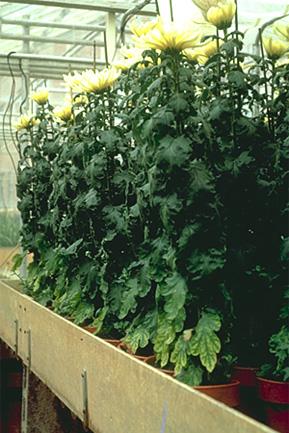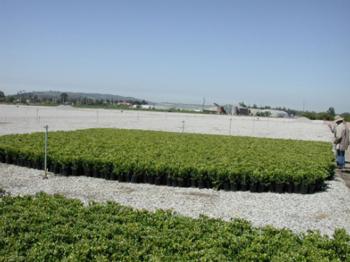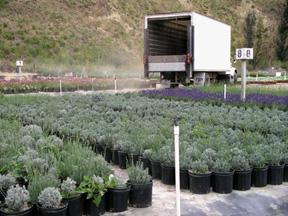GET CULTURED: When disease symptoms are caused by poor nutritional or cultural practices
by Don Merhaut
It can be difficult to distinguish plant biotic diseases caused by pathogens or insects from various abiotic disorders caused by mismanagement of cultural practices, poor nutrition, or some environmental issue. In the following article, we will help you determine the difference between biotic and abiotic disorders and discuss some of the more common abiotic disorders so that you can properly correct these issues or prevent these problems from happening.
One of the primary differences between biotic and abiotic disorders is that abiotic disorders are often expressed as a pattern on the plant or in the production bed, unlike biotic disorders which are not. For example, the deficiency symptom of a specific nutrient is typically expressed on all of the oldest or youngest leaves, depending on the nutrient in question. Usually, if there is a nutrient deficiency, all plants in the production bed will also express the same symptoms. On the other hand, the infestation of aphids will begin on one part of the plant, spreading from the point of initial infestation to other parts of the plant and to plants in proximity of the infected plant in a production bed.
To determine the cause of plant disorders, always take into consideration six factors:
- Media – temperature, hydrophobic/hydrophilic properties, pH, aeration, water holding capacity
- Fertilizers – amount, type and concentration of nutrients, formulation (liquid, granular, or polymer-coated fertilizers), application methods
- Cultural Practices – pruning, weed control, staking, greenhouse vs. field production practices, practices involving newly planted liners vs. mature, retail-ready plants, container type and color, use of growth regulators, etc.
- Irrigation Practices – type (overhead, drip, hydroponic, ebb and flow, hand-watering), scheduling, duration
- Weather and Environmental Conditions – humidity, wind, light conditions, air temperature, and pollution
- Plant Type – rooted liners, seedlings, different genera, species and cultivars
Below is a list of some of the more common abiotic disorders, their symptoms and causes.
Uniform stunting of healthy plants in entire production bed. Lack of fertilizer can lead to this type of abiotic disorder symptom. Another cause can be mismanaged cultural practices such as too little or too much water (if no fertilizer is in irrigation water), compacted, poorly aerated media (causing poor root growth), or improper application of growth regulators. This abiotic disorder can also be caused by unsuitable weather or greenhouse environmental conditions for plant growth.
Entire plant is chlorotic and all plants are chlorotic and stunted in the production bed. This can be caused by insufficient fertilizer or compacted or poorly aerated soil which is limiting root growth and function. However, if symptoms are not uniform for the entire production bed, a root pathogen is possible.
Non-uniform plant growth in a production bed. Sometimes some plants are stunted, some appear normal, and yet others are vigorous. This may be caused by improper blending of fertilizers into the media, so that some plants have insufficient fertilizer, while other plants have enough, and some plants have a lot or too much fertilizer. These symptoms may also be caused by improper application of growth regulators.
Uniform yellowing of oldest leaves on all plants in the production bed. This is usually caused by a deficiency of a specific nutrient in the fertilizer program. The nutrient would be one of the mobile elements such as nitrogen, magnesium (fig. 1), potassium, and sometimes immobile elements such as sulfur or molybdenum. With sulfur and molybdenum deficiency symptoms, yellowing may also occur throughout the plant canopy, not just the newest or oldest leaves. The crop manager should check the fertilizer program for an adequate complement of the mobile nutrients mentioned and/or take a tissue sample for nutrient analysis.
Figure 1. Magnesium deficiency symptoms in mums appear as a uniform interveinal chlorosis of oldest leaves. Magnesium deficiencies may be caused by lack of magnesium in the fertilizer program or high concentrations of ammonium and potassium relative to magnesium concentrations in the fertilizer regime.
Uniform yellowing of newest growth on all plants in the production bed. These symptoms are usually indicative of a deficiency of one or more of the immobile plant essential nutrients: calcium, iron, manganese, copper, boron, zinc, sulfur, molybdenum. Media pH also may be a problem since many micronutrients are precipitated as soil pH increases above 6.0 (molybdenum is the exception).
Uniform yellowing and deformation of newest growth on entire plant and all plants in the production bed. These symptoms are usually associated with particular immobile micronutrients such as manganese, copper, boron and zinc. Also, when these symptoms are not uniformly expressed in the entire production bed at the same time, insect or pathogen attack of the new growth is feasible.
Uniform reddening of oldest leaves and stems. This is a common phosphorus deficiency symptom and may be associated with phosphorus unavailability to growing roots due to improper fertilizer placement or lack of sufficient phosphorus in the fertilizer. Symptoms may also be caused by cold soils or media, which would limit adequate root growth to take up phosphorus.
Non-uniform symptoms in a production bed. Sometimes, abiotic disorders appear to be random in a production bed. For example, a leaking irrigation emitter may cause excessive watering and leaching of nutrients from containers in proximity of the faulty emitter. In this case, plants may become chlorotic only in this area. Low spots in production beds may cause root dieback in waterlogged containers, which may eventually lead to disease. Proper construction of production beds, taking into consideration slope, drainage, and surfaces such as gravel (fig. 2), will allow for necessary drainage after irrigation or rain events.
Figure 2. Properly constructed production beds. Soil was compacted to prevent leaching of fertilizers and pesticides into the ground; several inches of gravel were placed on top of the compacted soil to provide drainage of irrigation and rain water away from containers and to minimize the spread of weeds and pathogens in the bed.
Dust, wind, and rodents can also cause random abiotic symptoms. Dust that accumulates on foliage of containers near roads (fig 3) may cause necrosis or other damage to foliage. In some areas, field mice and other rodents may chew the bark off of plants at ground level; total girdling will cause wilting followed by whole plant death. Where plants are on individual drippers, rodents and small mammals will chew off dripper tubes to get to the water, especially in areas where water is scarce, which can lead to random abiotic disorder symptoms. When it is windy, some plant species blow over; when the foliage hits the ground, it can be predisposed to diseases from the soil. Tall plants, which may easily fall over, should be tied or staked in place in some way. 
Figure 3. Dust blowing up from dirt roads and landing on production beds downwind. Dust on roads can be minimized by gravel or paving, or by spraying roads with water.
In conclusion, as part of an integrated pest management (IPM) program, it is imperative to keep good records on all aspects of production: weather, fertilizer programs, irrigation programs, pesticide spray programs, management of pests including rodents and other animals in problem areas. Proper record keeping will help minimize the likelihood of abiotic disorders repeating themselves and will also minimize or prevent the introduction of pests and diseases that often attack already weakened or poorly grown plants. Additionally, it is important to begin a nursery operation with a properly designed and constructed production area, including roads, drains, and production beds. Finally, for commonly grown crops, a nutrient analysis of tissue is recommended. When possible, healthy tissue should be compared to unhealthy tissue.
Don Merhaut is a UC Cooperative Extension Specialist for Nursery and Floriculture Crops, Department of Botany and Plant Sciences, UC Riverside.












